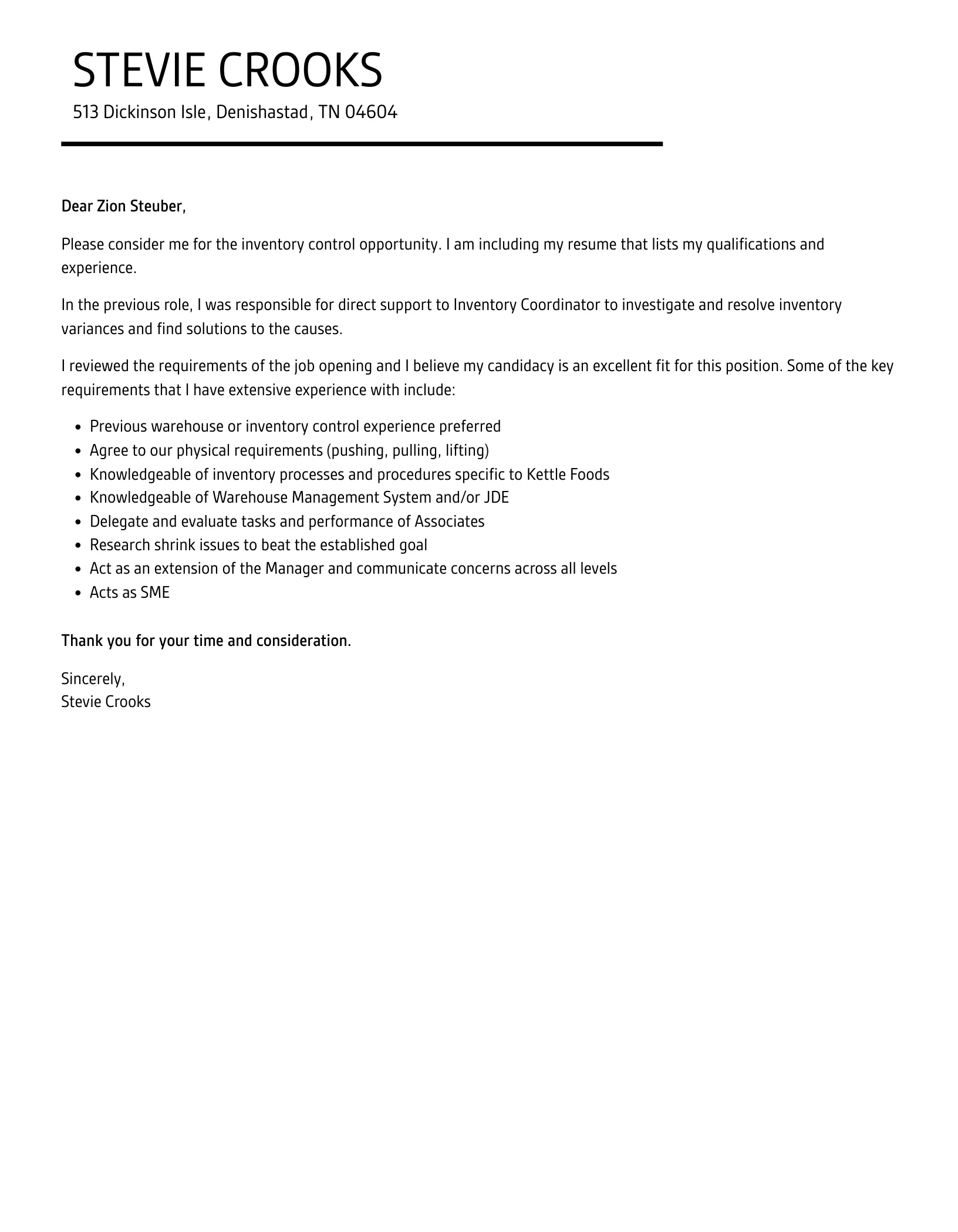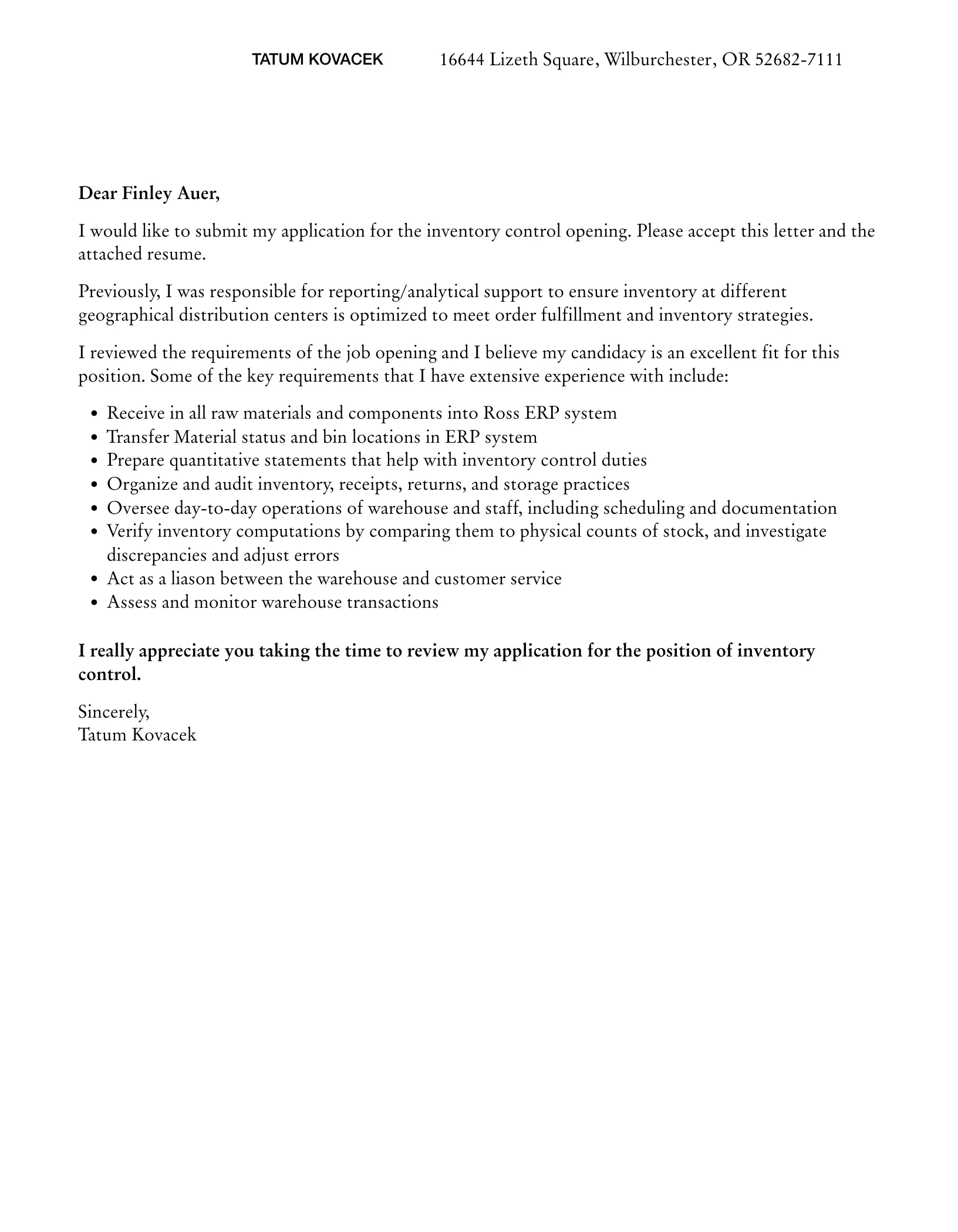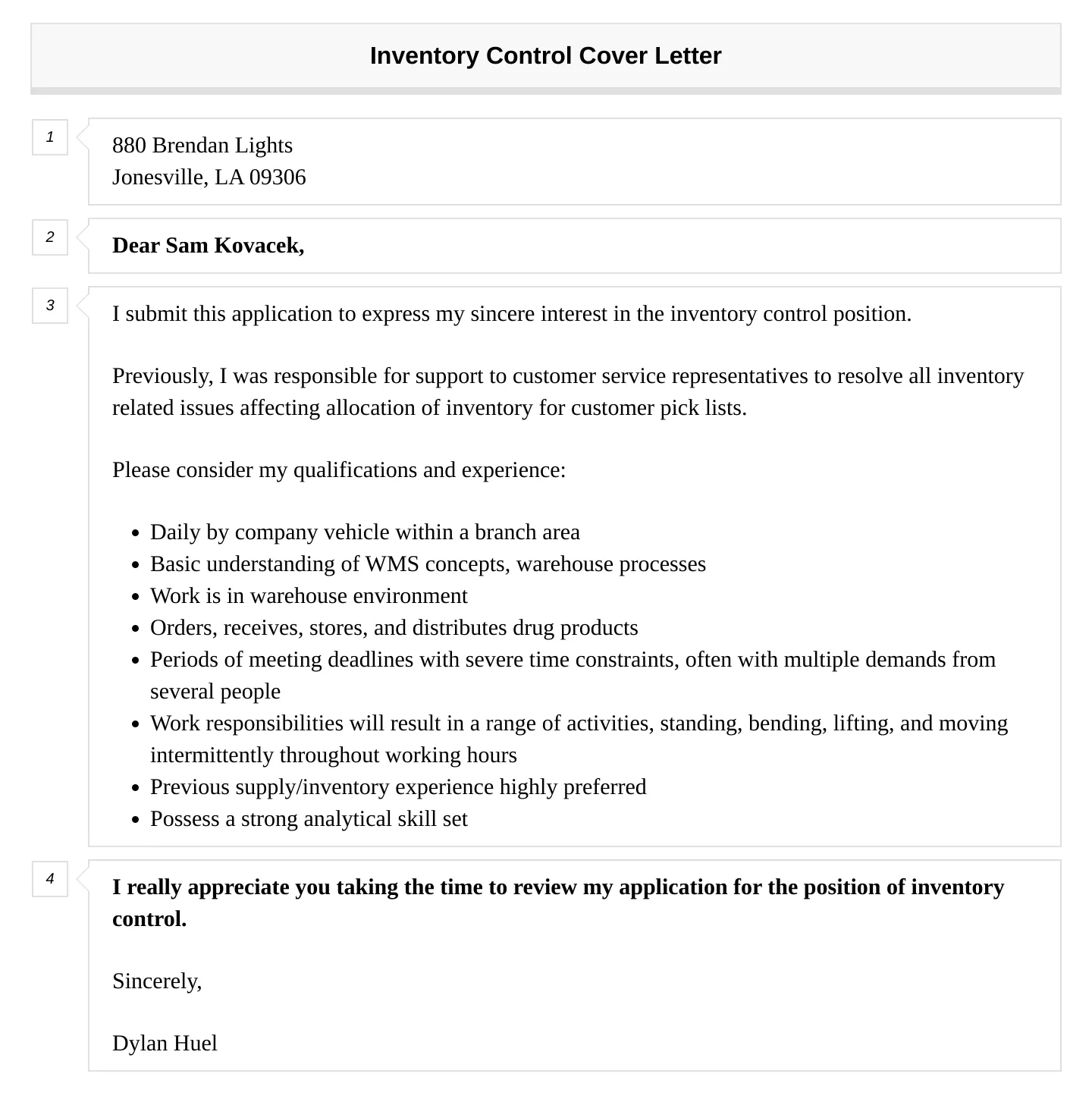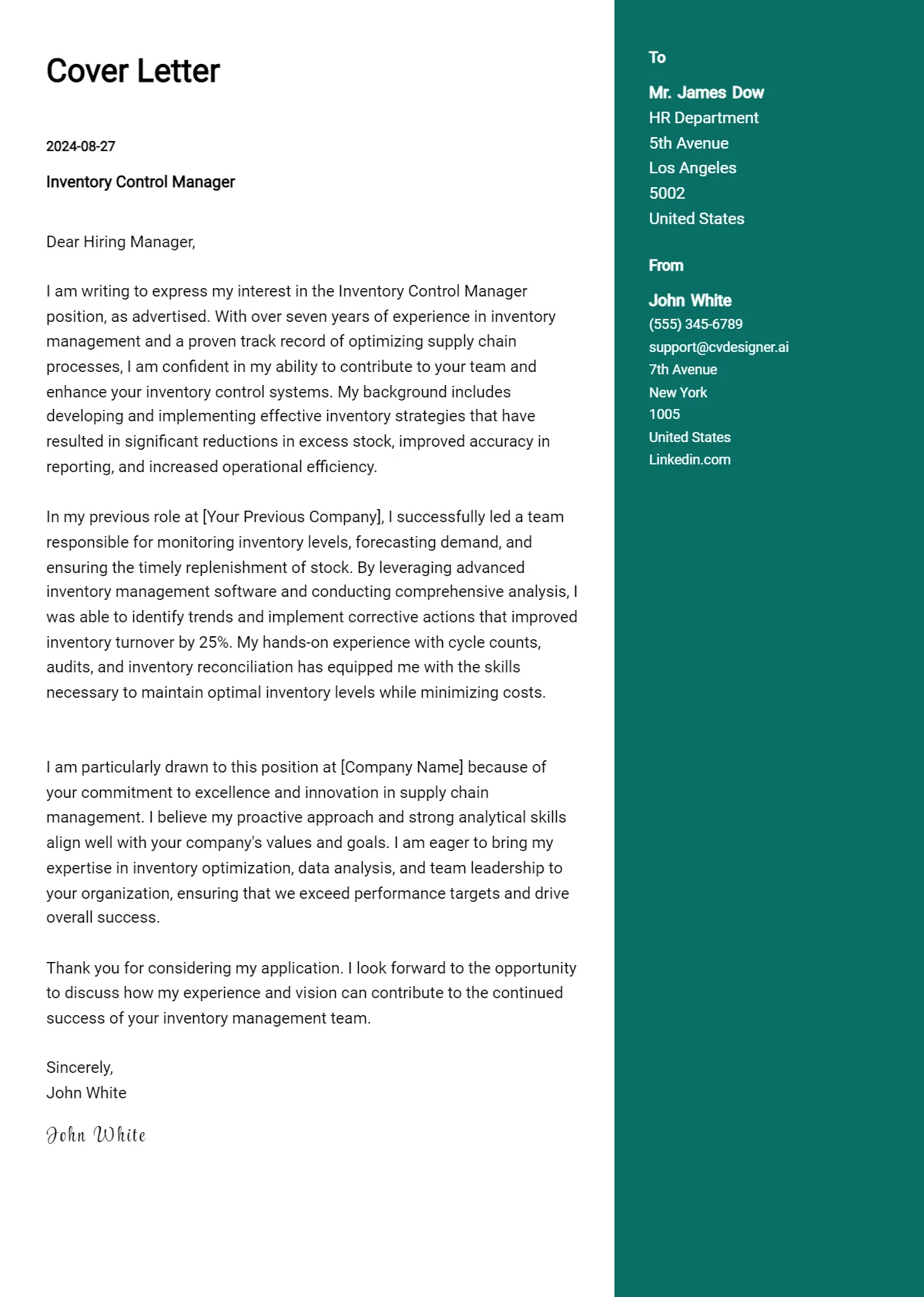Cover Letter Inventory Control What is it?
A cover letter for inventory control is a critical document that accompanies your resume when applying for inventory control positions. Its primary purpose is to introduce yourself to the hiring manager, showcase your relevant skills and experience, and express your interest in the specific role. Unlike a resume, which provides a factual overview of your professional history, a cover letter allows you to personalize your application and explain why you are the ideal candidate. A well-crafted cover letter demonstrates your understanding of inventory control principles, your ability to perform the required tasks, and your enthusiasm for the opportunity. It should highlight your key strengths and achievements, aligning them with the requirements outlined in the job description. This document offers a platform to elaborate on your qualifications, making a compelling case for why you deserve an interview and ultimately, the job. A strong cover letter often sets the tone for your entire application, leaving a lasting positive impression on the hiring manager.
Essential Skills for Inventory Control Cover Letters
When writing a cover letter for inventory control, it’s important to emphasize the essential skills that align with the job requirements. These skills demonstrate your capability to effectively manage inventory, reduce costs, and ensure efficient operations. Start by showcasing your knowledge of inventory management principles, including stock control, forecasting, and cycle counting. Highlight your proficiency in relevant software and systems used for tracking and managing inventory. Data analysis and reporting abilities are crucial, so mention your capacity to analyze inventory data, generate reports, and identify trends to make informed decisions. Strong communication and teamwork skills are also vital, as inventory control often involves collaboration with various departments and stakeholders. A cover letter should also reflect problem-solving skills, attention to detail, and the ability to work under pressure while meeting deadlines. By emphasizing these skills, you increase your chances of catching the hiring manager’s attention and demonstrating your suitability for the position. Always tailor your skills to the specific job description, highlighting the skills that are most relevant and prioritized by the employer.
Inventory Management Software Proficiency

Proficiency in inventory management software is a key asset in the field of inventory control, so it should be highlighted prominently in your cover letter. Such software enables efficient tracking, analysis, and management of inventory levels. Mention specific software you are familiar with, such as SAP, Oracle, Fishbowl, or any other system the employer lists in the job description. Describe your experience using the software for tasks like data entry, inventory tracking, generating reports, and optimizing stock levels. Explain how you have used these tools to improve inventory accuracy, reduce discrepancies, or streamline processes. Quantify your achievements whenever possible, such as the percentage reduction in errors you achieved or the amount of time saved by implementing software solutions. If you are proficient in any specialized features or modules within the software, make sure to mention them. Your software proficiency demonstrates your practical skills and your ability to contribute effectively to inventory management operations. Always emphasize your commitment to continuous learning and your willingness to adapt to new software platforms.
Data Analysis and Reporting Abilities
Data analysis and reporting are crucial skills in inventory control, so they should be emphasized in your cover letter. Inventory control involves collecting, analyzing, and interpreting data to make informed decisions about stock levels, ordering, and cost control. Mention your proficiency in data analysis techniques, such as trend analysis, forecasting, and variance analysis. Highlight your ability to use software tools like Microsoft Excel or specialized inventory analysis programs to gather, analyze, and interpret data. Describe your experience generating reports, including inventory reports, stock-level reports, and variance reports. Explain how you have used data to identify issues, optimize processes, and make recommendations for improvement. Quantify your achievements whenever possible, such as the percentage reduction in inventory costs or the improvement in inventory turnover rates you achieved through data analysis. Your data analysis and reporting skills demonstrate your ability to make data-driven decisions and contribute to the overall success of inventory control operations. Tailor your descriptions to the specific requirements of the job and emphasize any data analysis techniques or reporting tools listed in the job description.
Communication and Teamwork Skills
In the field of inventory control, effective communication and teamwork are essential for success. Mention your experience collaborating with various departments, such as purchasing, sales, and operations, to ensure smooth operations. Highlight your ability to communicate clearly and concisely, both verbally and in writing, as you will need to provide reports, make recommendations, and relay information to various stakeholders. Showcase your ability to work effectively in a team environment, contributing to a positive and productive workplace. Describe instances where you have successfully collaborated with others to achieve shared goals, such as implementing new inventory processes or resolving inventory discrepancies. Give examples of how you’ve used your communication skills to resolve conflicts, negotiate with suppliers, or train other team members. Highlighting these skills demonstrates your ability to work effectively with others, and ensure the smooth flow of information between departments, which is crucial for accurate inventory control and overall operational efficiency. Emphasize these skills by highlighting any instances where you have improved communication or teamwork within a previous role.
Formatting Your Cover Letter for Inventory Control Positions

Proper formatting is crucial for a professional cover letter. The formatting includes several important elements, starting with the header and contact information at the top of the page. Include your full name, address, phone number, and email address. Following this, the greeting sets the tone for your communication, using ‘Dear Mr./Ms./Mx. [Last Name]’ if you know the hiring manager’s name, or a general greeting if you don’t. The introduction paragraph must grab the reader’s attention, stating the position you’re applying for and quickly summarizing your top qualifications. In the body paragraphs, delve into your skills and experiences in detail. Each paragraph should focus on a different skill or achievement, supporting your claims with specific examples and results. Make sure to clearly outline how your experiences align with the job description and employer needs. Finally, the closing paragraph should summarize your interest, reiterate your key skills, and include a call to action, such as requesting an interview. Ensure your formatting is clean, readable, and free of errors, utilizing standard fonts and margins. Maintaining a professional tone and structure will help make your cover letter stand out and impress the hiring manager.
Header and Contact Information
Your cover letter’s header and contact information serve as a crucial first impression and should be accurate and professionally formatted. Begin by including your full name, centered at the top of the page. Below your name, provide your complete mailing address, followed by your phone number and a professional email address. Ensure that all contact details are current and easy to read. Use a standard, easy-to-read font style and size, such as Times New Roman or Arial, size 11 or 12. Avoid using any unnecessary graphics or designs in the header that could distract from the content. The header should be clean, uncluttered, and clearly formatted, making it easy for the hiring manager to quickly find your contact details. Double-check all the information to avoid any typos or errors. A well-formatted header with correct contact information enhances your application and ensures that the employer can easily reach you.
Greeting and Introduction
The greeting and introduction of your cover letter are key to making a positive first impression. If possible, address your cover letter to a specific person, such as the hiring manager or the department head. If you’re unsure of the name, research the company’s website or use a general greeting. The introduction should state the position you are applying for and where you saw the job posting. Briefly introduce yourself and highlight your main qualifications or skills that align with the job requirements. Aim to capture the reader’s attention in the first few sentences, showing your enthusiasm for the role and your understanding of the company’s needs. Avoid generic introductions; instead, personalize your letter and show your genuine interest. Maintain a professional tone, using clear and concise language. The introduction should set the stage for the rest of your cover letter, conveying why you are a great fit for the position. A well-crafted greeting and introduction will pique the hiring manager’s interest and encourage them to continue reading.
Body Paragraphs Highlighting Relevant Skills

The body paragraphs are the heart of your cover letter, where you showcase your skills and experience. Structure your paragraphs to highlight key skills, aligning them with the job description. Each paragraph should focus on a specific skill or achievement. Provide concrete examples of how you have used those skills in previous roles. Use the STAR method (Situation, Task, Action, Result) to provide detailed context, explaining the situation, the task you faced, the actions you took, and the results you achieved. Quantify your achievements whenever possible, using numbers and metrics to demonstrate your impact. Tailor the content to match the specific requirements of the job, emphasizing the skills and experiences that are most relevant to the position. Show, rather than tell, by providing specific examples that illustrate your abilities. For example, if the job requires inventory tracking skills, describe how you’ve used inventory management software, how you ensured data accuracy, and any improvements you made to the tracking process. By providing clear and detailed examples, you make a compelling case for your qualifications. Ensure a logical flow between paragraphs, connecting the points and showing how your skills and experience make you the ideal candidate.
Quantifying Achievements and Results
Quantifying your achievements and results is a powerful way to demonstrate your value to a potential employer. Instead of simply stating that you possess a skill, provide specific, measurable examples of how you have used that skill to achieve positive outcomes. Use numbers and data to showcase your impact. For instance, if you improved inventory accuracy, state the percentage by which you reduced discrepancies. If you streamlined a process, indicate how much time or money you saved. When describing your contributions, use metrics such as the amount of inventory managed, the cost savings achieved, the reduction in errors, the improvement in turnover rates, or any other relevant performance indicators. Use specific examples to quantify your accomplishments. For example, “Reduced inventory discrepancies by 15% within one quarter by implementing a new cycle count system.” By quantifying your achievements, you provide concrete evidence of your skills and the value you can bring to the company. This makes your cover letter more compelling and demonstrates your ability to make a real impact in the role. Always use quantifiable data to support your claims.
Closing and Call to Action
The closing of your cover letter should be professional, concise, and leave a lasting impression. Reiterate your interest in the position and summarize your key skills. Express your enthusiasm for the opportunity and how you are the right fit for the company. Include a strong call to action to encourage the hiring manager to take the next step, such as requesting an interview or a discussion. Make it easy for the hiring manager to contact you by restating your availability for an interview. Thank the reader for their time and consideration. Proofread the entire cover letter to make sure it is free of any errors and has a professional tone. The closing is your final opportunity to convince the hiring manager of your suitability for the role. A well-written closing will leave a positive impression and significantly improve your chances of getting an interview.
